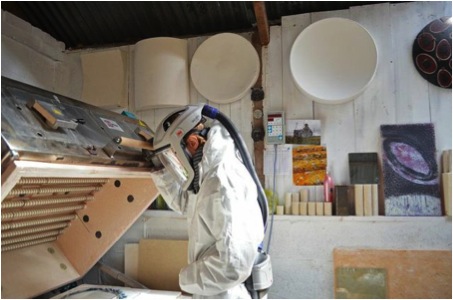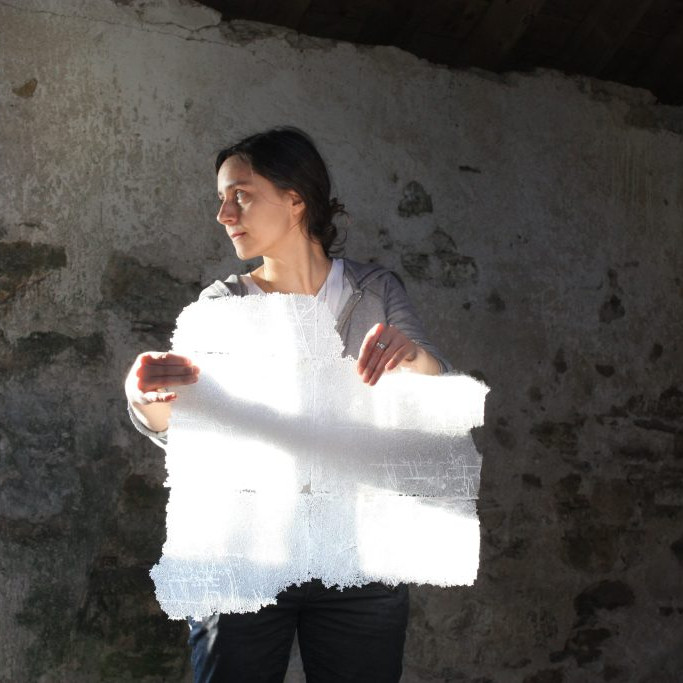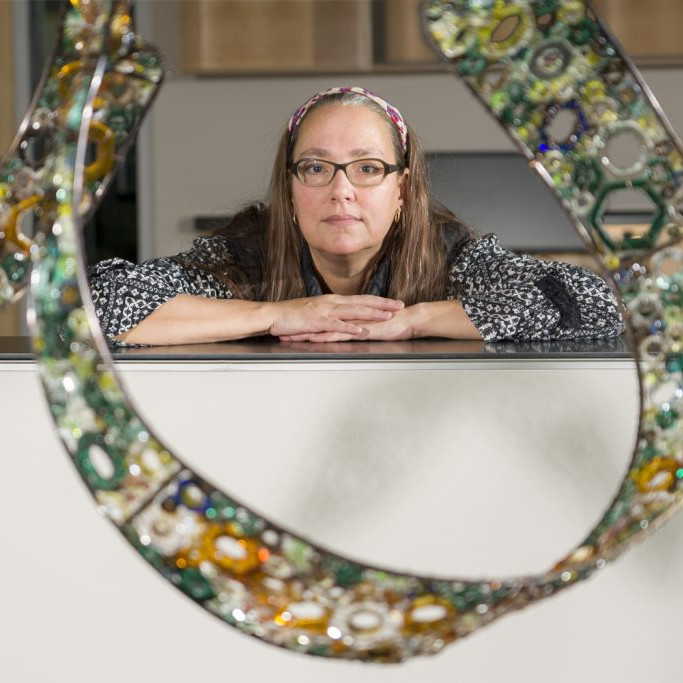Amanda Simmons Glass Artist - Galloway, Scotland
You have been working with glass powders. Can you explain the affects you are achieving using this method?
Using glass powders has changed the direction of my work from semi-functional to sculptural. It is still a very process led practice but one where I am constantly challenging the glass to be at its very limits. Using very thin layers of glass powders instead of sheet glass I can create paper thin delicate glass vessels that still have integrity of form but possess balance and some movement in their unrestricted profiles.
I can use many more layers of colour and enjoy blending my own mixes from the extensive Bullseye range of powders playing very much with contrasts in tone and shades. I am also finding the marks I now make in the powder are much less restricted and more gestural that work well with the gravity stretched forms.e movement in their unrestricted profiles.
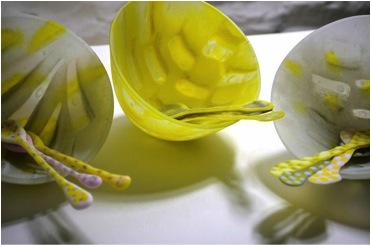
Candy Group’
Your work although functional almost defines gravity. Can you expand on this?
The work has become less and less functional due to its fragility and balance but I would say gravity very much defines my work. I can, to some extent, control mass, heat and time but gravity and hidden depths in the glass define the passage the vessel form will take in mid-air through the firing process. I have been playing with these forms almost exclusively now for 7 years and I’m still learning with every new body of work and always come out with more questions than answers…so they keep growing and changing form. I find it fascinating that the process of mass, heat, time and gravity has shaped our Universe and that it is these methods are my main focus in my work, and ideas that I’m now researching along with contemporary Cosmic Philosophy.
Can you explain about cameo glass and how you work with this method?
Cameo engraved glass is a technique of engraving through layers of glass to reveal the colour beneath. I use mainly opaque glass in my work but love using engraving to bring more light and colour through in places of the vessel. The technique works really well in terms of using diamond tool marks in the glass that stretch and change when the vessel is formed.
Colour is very important to your glass can you elaborate on this?
Colour is a large part of the ‘visual language’ I apply when designing my work. As I produce mostly 3D forms I’m also thinking about how the colours will blend and react with each other when seeing the piece as a whole with light. I like to have bold colours and contrast in my work as the processes of slumping and sandblasting the glass mutes and dilutes colours, but generally I just love colour. I set myself a challenge a few winters ago as I felt I had got stuck in a rut with colour choice; choosing to look at colour combinations from nature I produced a range of vessels directly inspired by the garden birds and started to use yellow, reds and oranges which had never made an appearance up till then. This small experiment, opened up my colour choices (and made quite a fun piece).
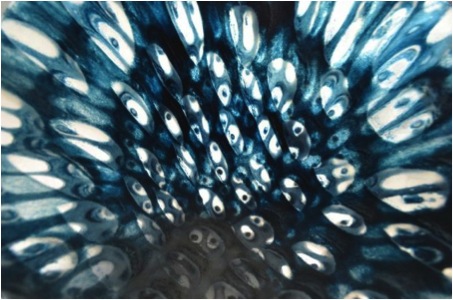
Powder design
Exhibition work is a huge part of your work. Why do you like working within exhibitions?
It wasn’t planned. When I first started out (and sure it’s the same for most people) I had no idea where I wanted this new career to take me; originally I started with architectural glass but didn’t enjoy the long timescales involved in these projects and quickly realised I liked making objects for the gallery market. I have never produced many pieces in one range and prefer to make one-off objects so it made sense to work towards exhibitions where I could work on small collections of work that had room to grow and change from one exhibition to the next.
You had 8 exhibitions in 2012 and already you are working on 6 for 2013. How do you keep up with the demands?
It’s a 24/7 type of job; I work from home and can fit other obligations/life around my working schedule. I’m lucky that I can just walk up the garden to my workshop to check on a firing or do short bursts of work in-between keeping up-to-date of the business side of things. I’m passionate about glass and enjoy progressing and working through technical and metaphorical issues and feel this is life not a job. I left a very stressful full-on medical job to become an artist, a very conscious decision to change my life, so although it can be very hard sometimes to keep up with the physical demands of the work or when things go wrong, I know I wouldn’t want to be doing anything else!
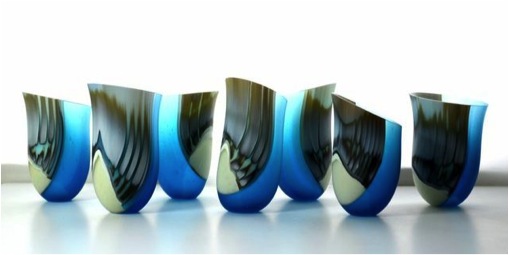
‘Cupid’
Do you work for solo or group exhibitions; can you expand how each works for you?
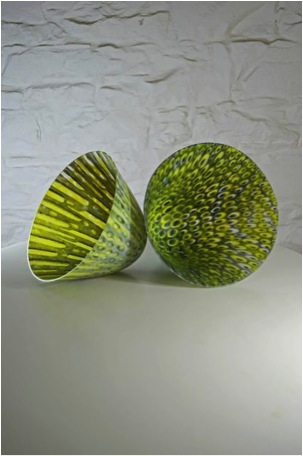
Expansion
Titles and themes mostly hinder! I tend to only take on shows that have a resonance for me like my three most recent exhibitions; ‘Coalesce’ at London Glassblowing I thought worked perfectly as my work is built from many parts coming together. ‘Colour’ at New Brewery Arts in Cirencester speaks for itself I think; and a collective show of artists from my local region of Dumfries and Galloway showed at Bianco Nero Gallery in Yorkshire.
The images you have are beautiful. Can you explain the importance of professional images for your work?
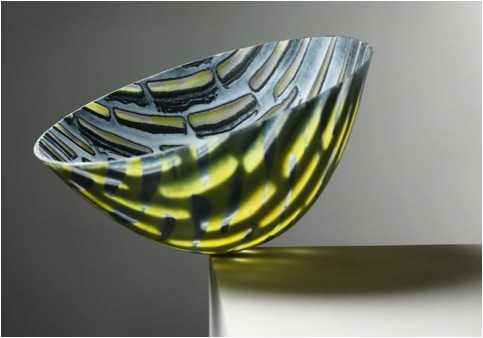
‘lost at Sea’ – Shannon Tofts
Thank you….I mostly take my own images as I’m forever working right up to the delivery deadlines and of course I need a reference of my work and like to have images to help advertise the show. I find more galleries now want images of all work so that it can go on-line for their own publicity. I’ve been interested in photography since a child (almost becoming a freelance photographer for bands and live performance) but the technical side never interested me but I do like playing with lighting and placement to make my work look in context. The professionals I have used over the years including Shannon Tofts ( www.shannontofts.com)) and Colin Tennant (www.colintennantphotography.co.uk/) have been brilliant to work with and just wish I could get more organised to do this more often. It’s so important in this business to represent your work well.
Colour and shape, please discuss this. Perhaps you could take 2 or 3 pieces and discuss this using them as examples?
The technique I employ most in my work, slumping glass through hand-built suspension moulds can create many different forms depending on the variability’s of mass, heat and time (and colour and opacity to some extent)…[starting with fusing layers of glass together to create ‘mass’, playing with colours and textures at this stage which affect the form of the vessel, then this piece goes back in the kiln placed over a mould that has a ‘hole’ cut in the middle, at around 650 degrees centigrade the glass starts to soften and slumps through the ‘hole’ creating the vessel shape – controlled by heat and time. The work is finished by a variety of coldworking techniques such as flat bed diamond grinding, diamond wheel lathe engraving and sandblasting]
My favourite form I’m working on at the moment is ‘Expansion’ and ‘Expansion Theories’. I’m trying to investigate the formation of the Universe and understand some of the most current theories using the same universal physics of mass, heat and time. The vessels become very thin through the stretching process, just a few millimetres all over but having gone through a very rigorous coldworking regime to finish, still safe objects to display.
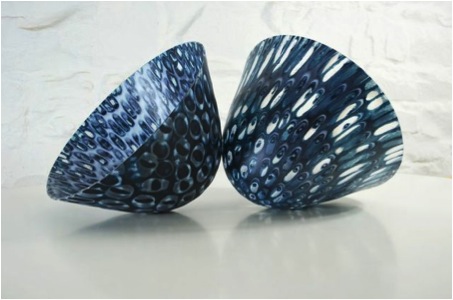
Expansion Theories
They can take a few hours to form in the kiln (on top of the heating up to top temperature and cooling stages) and it’s important that I’m close by to watch the progress of the slump; different colours, opacity and weight can make this process longer or much quicker.
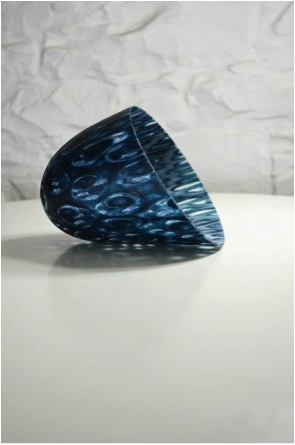
Expansion Theory
The other forms I’m enjoying are the larger ‘platter’ type vessels which take the slumping process to the extreme. These pieces are finely balanced over the mould and with careful manipulation of top temperature and speed of getting there I make the glass fall through the aperture, often manipulating the glass with heatproof accessories to change the form as it cools. I’m looking for ‘organic’ fluid shapes in these pieces and like when they fold in on themselves.
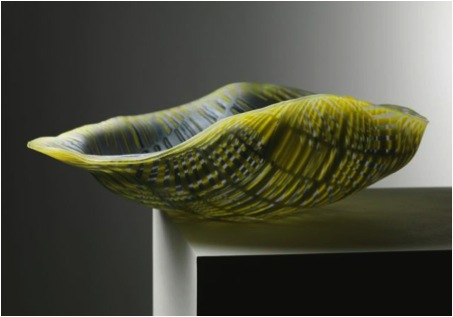
‘Platter’
I’m looking for a bold but uncomplicated form that creates a balance between the inside and out.
You have been working with glass for over 10 years, can you discuss 2 highlight in your career during this time?
I’ve enjoyed every step of the way, the people I’ve met, the countries I’ve travelled to and the organisations and galleries that I have worked with throughout the years have all added to a wonderful growing experience. The two highlights of my career so far though would be exhibiting at Collect at the Saatchi Gallery in London and taking part in a residency at North Lands Creative Glass in Lybster, Caithness, Scotland.
I was accepted as part of a collective to show on the Craft Scotland stand at Collect 2011. This is the largest exhibition of International craft and applied objects in the UK and a show I had visited since my student days for inspiration, education and fuelling of my passion for contemporary crafts. Seeing my work exhibited at this type of show made me realise that I had made the right decision to change my life, taking the huge risk of leaving a good salary and trying to make it in this world as an artist. It opened other ‘doors’ for me in the business and helped greatly in getting a good audience for my work.
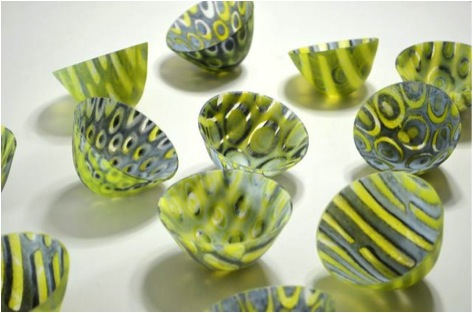
‘Lost at Sea’ Small Kilnformed Glass Vessels
My other highlight is on a more personal development level and an event that I feel totally changed my practice and the way I work…in just 10 days. I was invited on a residency of professional glass artists by the American artists Steve Klein and Richard Parrish based at the internationally renowned glass centre, North Lands in Caithness. This was an intensive 10 day residency focusing on kiln formed glass in architecture which I thought I may re-visit (in fact it helped me realise I was definitely a gallery based artist). We visited very traditional but derelict Scottish buildings around Lybster and then time and space to realise ideas. A round table discussion of the entire group started our days along with trips further afield in the region. I was very kindly sponsored on the residency by Lani McGregor, one of the owners of Bullseye Glass in Portland, OR in return for a glass piece inspired by the residency and surrounding area; this level of support from Lani, a pioneer in the glass industry, gave me a huge amount of confidence in my work and helped me realise that I produce my best work when I feel passionate about a subject and spend more time researching and thinking.
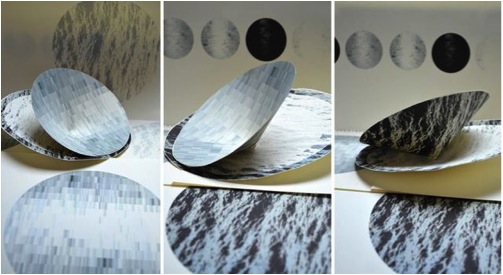
‘North Lands’ – Paper samples
Tell us about your studio and the space you need to have?
I have a large, tall tin shed that I have added to over the years to suit my needs (wood burning stove and insulation as it can get very cold here in the Galloway hills, a new mezzanine storage level and some new roof panels to let in more light). I have a lot of equipment, 3 kilns, coldworking tools (grinder, lathe, sandblaster) and sheet and powdered glass storage and as I’m not the tidiest of people many portable work benches to store work in progress. I think with craft practices we work to the space we have available and to the size of the equipment. I’m limited in the size of my pieces to the size of my kilns but have on occasion rented out bigger equipment to make one-off pieces. Working any larger than I am now would get too physical for me on my own and I am limited by the electricity supply to my workshop so no bigger kilns!
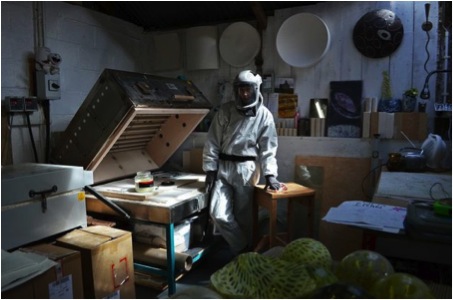
Amanda Simmons in her studio
You must have an excellent work ethic to produce the work you do. Discuss the division of your time in the studio, and teaching?
In 2012 I took on a lot of teaching as the invites kept coming and it was a wonderful way to travel the world and meet many more glass artists. However, it did impair my own practice as it left no time for the development of my work. Lesson learned; this year I’ve postponed many of my invites (including USA and Denmark) and will certainly take less on in the future. I like teaching and passing on the knowledge I’ve gained and it’s great to get out from the studio now and again but I mostly prefer working alone in my studio in this beautiful part of the country. I work most days but to my own timetable and have to limit the physical side of my practice due to health issues but find there is always plenty to do on the computer.

Teaching takes you to many places can you elaborate on your teaching and how people can catch up with classes with you and the standard they need to be at?
I teach a little at a local level which is mainly beginner/hobbyist level. All the teaching I do away from Dumfries and Galloway has been specifically my version of kiln formed glass vessels and although beginners can learn this easily it does help to have fusing and slumping experience (also previous coldworking practice is very useful). Hopefully I’ll be heading to the states next year and will advertise these when confirmed on my website/blog/Facebook. I would love to visit Australia one day as there are so many exciting glass artists based there.
You are a member of The Contemporary Glass Society. Can you discuss the importance of the membership to you?
CGS is a wonderful organisation that continues to grow and gives a huge voice to glass artists in the UK and abroad. As I work mostly on my own (although there is a great network of artists in my region, there a very few working with glass) being a part of a glass society lets you know what’s going on in ‘glass world’, helps with making connections with other artists and organisations and encourages participation of exhibitions that they promote.
How could others become members?
Membership is open to all and the benefits for membership include the opportunity to participate in CGS workshops, exhibitions (including on-line), conferences and other events; a regular magazine with information about glass-related events and exhibitions in the UK and abroad, and to which members can submit articles, topical notices and advertisements; inclusion in the Membership Directory, accessed via the CGS website, with a link to members¹ sites where appropriate…and many more
Full membership is £55 (plus £5 for overseas members) and student rate of £30 (again plus £5 for overseas students) all available from www.cgs.org.uk
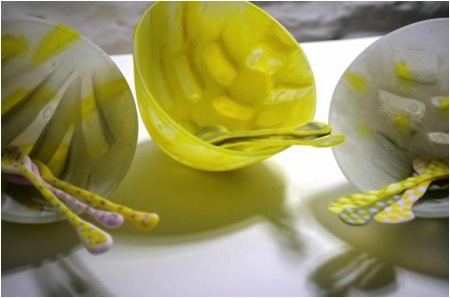
‘Candy’
Contact details.
Email: amanda.simmons@btinternet.com
Web: www.amandajsimmons.co.uk
Amanda Simmons, Corsock, Dunfries & Galloway, Scotland
Interview by Deborah Blakeley, May, 2013
Think a colleague or friend could benefit from this interview?
Knowledge is one of the biggest assets in any business. So why not forward this on to your friends and colleagues so they too can start taking advantage of the insightful information the artist has given?
Other artists you may be interested in:


